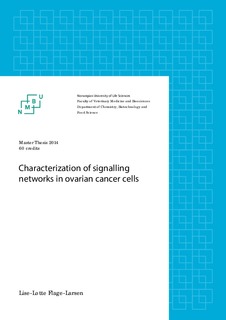| dc.description.abstract | Ovarian cancer is one of the most lethal gynaecological diseases worldwide, and in Norway approximately 500 women die from this disease every year. Women with ovarian cancer often experience vague symptoms that can be mistaken for much less severe diseases. This leads to late stage diagnosis of many patients, which is the main reason for why the overall five year survival rate is only around 40%.
Accumulation of malignant ascites is frequently observed in ovarian cancer patients that have reached stage III and IV, and it is known to support tumour progression, by creating a tumour friendly microenvironment. Our understanding of malignant ascites and its effect on the intracellular signalling networks in ovarian cancer cells is still unclear.
In this thesis we have tried to characterize intracellular phosphorylation pattern in ovarian cancer cell lines treated with ascites. We put particular focus on key proteins that are known to be involved in cell proliferation, cell survival and protein synthesis.
Our result show that several ovarian cancer cell lines; OVCAR-3, OVCAR-5, OVCAR-8, NCI/ADR-RES and SKOV-3, are suitable for the protocol that is established for these experiments.
Further experiments show that multiple intracellular proteins were phosphorylated upon treatment with ascites. Ovarian cancer cells that were treated with ascites from patient panel displayed with a different phosphorylation patterns, both between cell lines and patient samples. S-6 ribosomal protein exhibited a strong phosphorylation after SKOV-3 and OVCAR-8 cells were treated with ascites from most of the patients.
Ascites from any patient induced a distinct increase in phosphorylation between 3 and 20 minutes in both SKOV-3- and OVCAR-8 cells. STAT-3 phosphorylation seemed to be independent because of a low correlation with the phosphorylation of the other proteins. A strong phosphorylation was seen in STAT-3 after treatment with ascites from all the patient samples.
By using an IL-6R blocking antibody we showed that IL-6 was dominant when it comes to activation of JAK/STAT pathway and STAT-3 phosphorylation. There was no significant change in phosphorylation of other proteins when IL-6R was blocked and cells were treated with ascites. Though, -the overall phosphorylation response amongst the other proteins were weak.
We also observed that STAT-1 displayed a moderate to strong phosphorylation in SKOV-3 cells when treated with some of the patient samples. Other proteins that were investigated, like AKT, MAPKAPK-2 and MEK-1, displayed moderate phosphorylation after treatment with ascites from multiple patients in both OVCAR-8- and SKOV-3 cells. | nb_NO |

